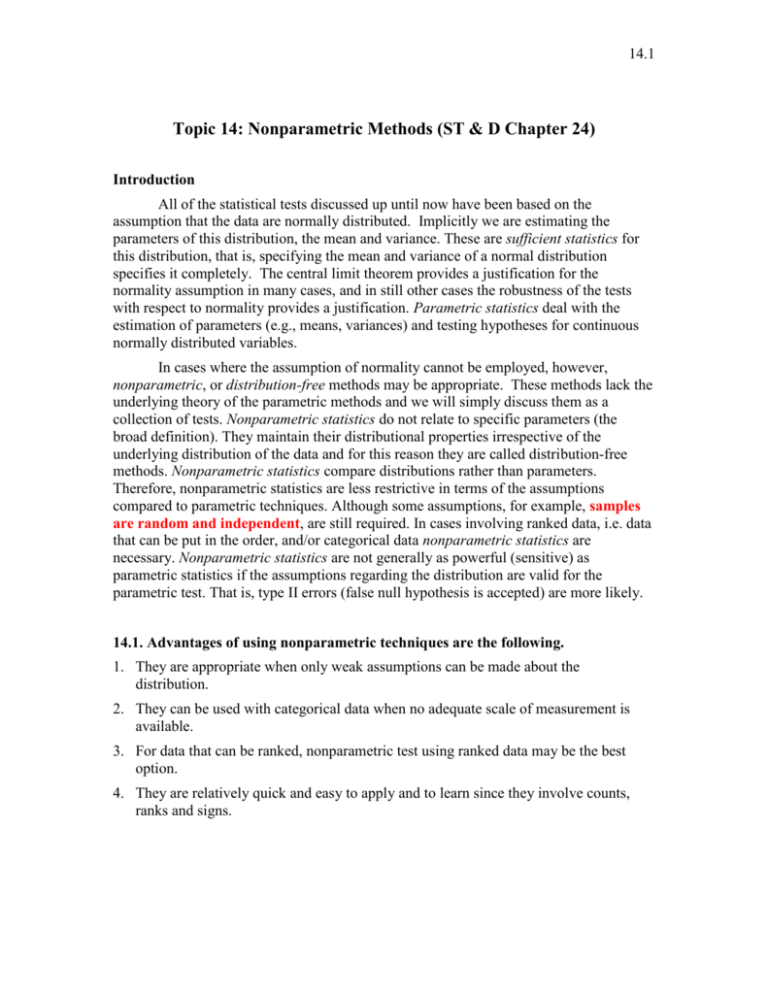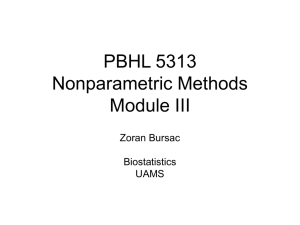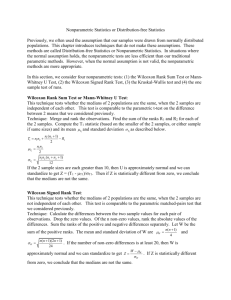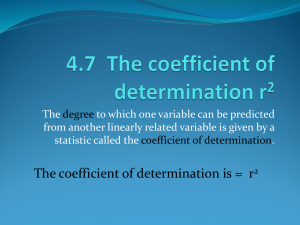Topic 14: Nonparametric Methods (ST & D Chapter
advertisement

14.1 Topic 14: Nonparametric Methods (ST & D Chapter 24) Introduction All of the statistical tests discussed up until now have been based on the assumption that the data are normally distributed. Implicitly we are estimating the parameters of this distribution, the mean and variance. These are sufficient statistics for this distribution, that is, specifying the mean and variance of a normal distribution specifies it completely. The central limit theorem provides a justification for the normality assumption in many cases, and in still other cases the robustness of the tests with respect to normality provides a justification. Parametric statistics deal with the estimation of parameters (e.g., means, variances) and testing hypotheses for continuous normally distributed variables. In cases where the assumption of normality cannot be employed, however, nonparametric, or distribution-free methods may be appropriate. These methods lack the underlying theory of the parametric methods and we will simply discuss them as a collection of tests. Nonparametric statistics do not relate to specific parameters (the broad definition). They maintain their distributional properties irrespective of the underlying distribution of the data and for this reason they are called distribution-free methods. Nonparametric statistics compare distributions rather than parameters. Therefore, nonparametric statistics are less restrictive in terms of the assumptions compared to parametric techniques. Although some assumptions, for example, samples are random and independent, are still required. In cases involving ranked data, i.e. data that can be put in the order, and/or categorical data nonparametric statistics are necessary. Nonparametric statistics are not generally as powerful (sensitive) as parametric statistics if the assumptions regarding the distribution are valid for the parametric test. That is, type II errors (false null hypothesis is accepted) are more likely. 14.1. Advantages of using nonparametric techniques are the following. 1. They are appropriate when only weak assumptions can be made about the distribution. 2. They can be used with categorical data when no adequate scale of measurement is available. 3. For data that can be ranked, nonparametric test using ranked data may be the best option. 4. They are relatively quick and easy to apply and to learn since they involve counts, ranks and signs. 14.2 14.2 The 2 test of goodness of fit (ST&D Chapter 20, 21) The goodness of fit test involves a comparison of the observed frequency of occurrence of classes with that predicted by a theoretical model. Suppose there are n classes with observed frequencies O1, O2, ..., On, and corresponding expected frequencies E1, E2, ..., En. The expected frequency is the average number or expected value when the hypothesis is true and is simply calculated as n multiplied by the hypothesized population proportion. The statistics 2 (O E ) 2 E has a distribution that is distributed approximately as 2 with n -1 degrees of freedom. This approximation becomes better as n increases. If parameters from the data are used to calculate the expected distributions the degrees of freedom of the 2 will be n –1–p; where p is the number of parameteres estimated. For example, if we want to test that a distribution is normal and we estimate the mean and the variance from the data to calculate the expected frequencies, the df will be n-1-2 (ST&D482). If the hypothesis is extrinsic to the data, like in a genetic proportion, then p=0 and df=n-1. There are some restrictions to the utilization of 2 tests. The approximation is good for n>50. There should be no 0 expected frequencies and expected frequencies <5 should not be present in more than 20% of the classes. If this is not possible, an alternative is to use Fischer’s Exact Test (ST&D 512, provided by SAS PROC FREQ). We can formulate the hypothesis test as follows. Let Ho be O1 = E1, ..., On = En, and let H1 be that Oi Ei for at least one i. Then Ho is rejected at the level of significance if 2 (O E ) 2 2 1-,n-1 E An adjusted 2 can be used when the criterion has a single degree of freedom in order to make the distribution of X2 more close to a 2 distribution (Yate’s correction for continuity). This adjustment produces a lower 2 and a more conservative test. adjusted 2 (| O E | .5) 2 E 14.2.1. One way classification Tests of hypotheses Test of hypothesis using the 2 criterion can be exemplified by tests of 1:1 sex ratio or 3:1 segregation test of dominance in F2 generation. 14.3 <Example 14.1> (ST & D p 488) Suppose a certain F1 generation of a Drosophila species with 35 males and 46 female. Test the hypothesis of a 1:1 sex ratio. (H0: p = q (with q = 1-p)) Sex Observed Expected Deviation (O) (E = p*n) (O-E) (O-E)2 (O-E)2/E Male 35 40.5 -5.5 30.25 0.747 Female 46 40.5 5.5 30.25 0.747 Sum 81 81 0 60.5 1.494 The 2 value is 1.494 with 1 df (= no. of classes –1). From table A.5, the probability for 1.49 with 1 df is between 0.1 and 0.25. Therefore, we fail to reject the null hypothesis that the sex ratio is 1:1. <Example 14.2> Using SAS, test the hypothesis of a 9:3:3:1 ratio, normal dihybrid segregation for the data of F2 progeny of a barley cross (ST&D p500). The observed characters are non-two-row versus two-row, and green versus chlorina plant color. The data were 1178: 291: 273: 156. (1=green, non-two-row; 2=green, two-row; 3=chlorina, non-two-row; 4= chlorina, two-row). data f2; input pheno count @@; cards; 1 1178 2 291 3 273 4 156 proc freq; weight count; tables pheno / testp = (0.5625, 0.1875, 0.1875, 0.0625); /* 9:3:3:1 */ run; The FREQ procedure produces one-way to n-way frequency and crosstabulation (contingency) tables. For one-way frequency tables, PROC FREQ can compute statistics to test for equal proportions, specified proportions, or the binomial proportion. For contingency tables, PROC FREQ can compute various statistics to examine the relationships between two classification variables adjusting for any stratification variables. Since the input data are in cell count form, the WEIGHT statement is required. The WEIGHT statement names the variable Count, which provides the frequency of each combination of data values. In the TABLES statement, Pheno specifies a table where the rows are pheno (in two way TABLES AA*BB specifies a table where the rows are AA and the columns are BB). 14.4 OUTPUT PHENO 1 2 3 4 Frequency 1178 291 273 156 Percent 62.1 15.3 14.4 8.2 Test Percent 56.3 18.8 18.8 6.3 Cumulative Frequency 1178 1469 1742 1898 Cumulative Percent 62.1 77.4 91.8 100.0 Chi-Square Test for Specified Proportions ----------------------------------------Statistic = 54.313 DF = 3 Prob = 0.001 The number of degrees of freedom is one less than the number of classes. We conclude that the data don’t follow the ratio of 9:3:3:1 with a probability of 0.001. 14.2.2. Contingency tables For more than one variable, data can be conveniently represented by two-way tables called contingency table. These tables are useful to test if two classification criteria are independent (test of independence) and if two samples belong to the same population in relation to one-classification criteria (test of homogeneity). These tests are based on the principle that if two events are independent, the probability of their occurring together can be computed as the product of their separate probabilities. Example 14.2 can be represented using a two-way table if a different question is asked. The new question is if the color and number of rows are independent. In genetic terms this is a test for linkage between the genes affecting the two traits. Example 14.3 demonstrates how to generate a contingency table using SAS and test the hypothesis of independence between two characters. The test of independence tests the goodness of fit of the observed cell frequencies to their expected frequencies. In this case, the test criterion will be the same as one way except degrees of freedom =(row-1)*(column-1) and the expected frequency can be obtained by: E row total column total grand total <Example 14.3> Perform the test of Independence with a 2 by 2 contingency table using the data from example 14.2. We test the hypothesis (Ho: pij = pi.*p.j) regardless of the true ratio. As a result, we reject the null hypothesis that two characters are independent. data f2; 14.5 input cards; 1green 1green 2chlor 2chlor c1 $ c2 $ pheno count; non2row two_row non2row two_row 1 1178 2 291 3 273 4 156 proc freq; weight count; tables c1*c2 / chisq nopercent nocum norow nocol; run; CHISQ option requests chi-square statistics for assessing association. To simplify the output: NOPERCENT suppresses display of the percentage in crosstabulation tables NOCUM suppresses display of cumulative frequencies and cumulative percentages in one-way frequency tables and in list format NOROW suppresses display of the row percentage for each cell NOCOL suppresses display of the column percentage for each cell TABLE OF C1 C2 Frequency‚non2row 1green ‚ 1178 2chlor ‚ 273 Total 1451 C1 BY C2 ‚two_row ‚ ‚ 291 ‚ ‚ 156 ‚ 447 Total 1469 429 1898 STATISTICS FOR TABLE OF C1 BY C2 Statistic DF Value Chi-Square 1 50.538 Likelihood Ratio Chi-Square 1 47.258 Continuity Adj. Chi-Square 1 49.623 Mantel-Haenszel Chi-Square 1 50.511 Fisher's Exact Test (Left) (Right) (2-Tail) Phi Coefficient 0.163 Contingency Coefficient 0.161 Cramer's V 0.163 Sample Size = 1898 Prob 0.001 0.001 0.001 0.001 1.000 4.60E-12 7.11E-12 <Example 14.4> One example in ecology is found in Sokal & Rohlf p 731. A plant ecologist samples 100 trees of a rare species from a 400 square mile area. He records for each tree whether or not it is rooted in serpentine soils and whether its leaves are pubescent or smooth. Soil Pubescent Smooth Serpentine 12 22 Non serpentine 16 50 14.6 <Output> STATISTICS FOR TABLE OF SOIL BY LEAF Statistic DF Value Prob ƒƒƒƒƒƒƒƒƒƒƒƒƒƒƒƒƒƒƒƒƒƒƒƒƒƒƒƒƒƒƒƒƒƒƒƒƒƒƒƒƒƒƒƒƒƒƒƒƒƒƒƒƒƒ Chi-Square 1 1.360 0.244 Likelihood Ratio Chi-Square 1 1.332 0.248 Continuity Adj. Chi-Square 1 0.867 0.352 Mantel-Haenszel Chi-Square 1 1.346 0.246 Fisher's Exact Test (Left) 0.176 (Right) 0.918 (2-Tail) 0.251 Phi Coefficient -0.117 Contingency Coefficient 0.116 Cramer's V -0.117 Sample Size = 100 We accept the null hypothesis that the leaf type is independent of the soil type in which the tree is rooted. 14.4. One-sample tests 14.4.1 The Kolmogorov-Smirov test and the normal probability plot (ST&D p 564) The 2 test is useful to test hypothesis about the distribution of data that fall in categories. For a single sample of data, the Kolmogorov-Smirnov test is used to test whether or not the sample of data is consistent with a specified continuous distribution function. This is a useful nonparametric test for goodness of fit applicable to continuous distributions. The Kolmogorov-Smirnov test does not require the assumption that the population is normally distributed. As we already saw in the previous chapters, a common graphical way for assessing normality of the data is the normal probability plot. If the data has a normal distribution, the plotted points will be close to a straight line with intercept ( Y ) and slope (s). The linearity of this plot can be measured by the correlation r between the data and their normal scores. A statistic (W) by Shapiro-Wilk’s test is used to test for normality for small to medium number of samples and Kormogorov-Smirnov statistic (D) is used for large samples. The test for normality of a single sample of data can be obtained using SAS proc univariate. 14.5. Two sample tests 14.5.1 The sign test for two paired samples (also one-sample test for median) The sign test is designed to test a hypothesis about the location of a population distribution. It is most often used to test the hypothesis about a population median, and often involves the use of matched pairs, for example, before and after data, in which case it tests for a median difference of zero. That is, the signed numbers serve to test the 14.7 null hypothesis that each difference has a median of zero (pluses and minuses occur with the same chances). The sign test does not require the assumption that the population is normally distributed. (n1 n2) 2 , with 1 df n1 n2 2 The values, n1 and n2 are the numbers of pluses and minuses. In many applications, this test is used in place of the one sample t-test when the normality assumption is questionable. It is a less powerful alternative to the Wilcoxon signed ranks test, but does not assume that the population probability distribution is symmetric. For paired observations we can also ask the question if treatment A gives a response that is C units better than that of B. To do this test record the signs of the differences Y1i – (Y2i + C) and apply the sign test. With this test is impossible to detect a departure from the null hypothesis with fewer than six pairs of observations. With 20 or more pairs this test is more useful. This test does not require a symmetric distribution. This test can also be used as a one-sample test, to test the null hypothesis that the median is a specified value. Record the number of observations above (n1) and below (n2) the specified value Use the previous equation. 14.5.2 Wilcoxon’s signed-rank test for paired treatments (also one-sample test for median) The Wilkoxon signed-rank test is an improvement on the sign test in terms of detecting real differences with paired treatments. The impovement is attributable to the use of the magnitude of the differences The steps of Wilcoxon’s signed-rank test are; 1. Rank the differences between paired values from smallest to largest without regard to sign. 2. Assign the signs (tied ranks including both signs are given averages) Difference +2 -4 -6 +8 +10 -12 +12 +15 Signed rank +1 -2 -3 +4 +5 -6.5 +6.5 +8 3. Obtain T+ and T- (sum of positive ranks and negative ranks respectively). Choose smaller one and call it T. T+= 24.5 T-= 11.5 4. Compare T with the critical value in Table A17. Note that small values of T are the significant ones. 14.8 Critical T=4 11.5>4 Not significant The Wilcoxon signed rank test can be also used as a one-sample test to analyze if the median is a certain value. The Wilcoxon signed rank test requires that the distribution be symmetric; the previous sign test (14.5.1) does not require this assumption. 14.5.3 The Kolmogorov-Smirnov test for two independent samples The null hypothesis is that the two independent samples come from an identical distribution. This test is sensitive to differences in means and/or variances, since is a test of the equality of distributions rather than of specific parameters. The algorithm for the test is: 1) Rank all observations in ascending order. 2) Determine the sample cumulative distribution functions Fn(Y1) and Fn(Y2). 3) Compute |Fn(Y1) - Fn(Y2)| at each Y value. 4) Find the maximum difference D over all values of Y. Compare it with a critical value in Tables A.22A (balanced design) and A.22B (unbalanced design). Example from ST&D 571 Y1 53.2 53.6 54.4 56.2 56.4 57.8 61.9 F1 (Y1) 1/7 2/7 3/7 4/7 5/7 6/7 Y2 F2 (Y2) 58.7 59.2 59.8 1/6 2/6 3/6 62.5 63.1 64.2 4/6 5/6 6/6 7/7 |F1 (Y1)- F2 (Y2)| |1/7-0|=1/7 |2/7-0|=2/7 |3/7-0|=3/7 |4/7-0|=4/7 |5/7-0|=5/7 |6/7-0|=6/7 D |6/7-1/6|=29/42 |6/7-2/6|=22/42 |6/7-3/6|=15/42 |7/7-3/6|=1/2 |7/7-4/6|=1/3 |7/7-5/6|=1/6 |7/7-6/6|=0 In this case the maximum difference D= 6/7=0.857 The critical value in Table A22B for =0.01 is 5/6= 0.83 Since D > critical value, we reject Ho We conclude that the samples belong to different populations 14.5.4. The Wilcoxon-Mann-Whitney location test for two independent samples This tests the hypothesis that two data sets have the same location parameter (the same median). Assume the data sets have size n1 and n2, where n1 < n2. The test procedure is this: 14.9 1) Rank all observations from both observations together from smallest to largest (Tied observations are given the mean rank. 2) Add the ranks for the smaller sample. Call this T. 3) Compute T' = n1(n1 + n2 + 1) - T. T' is the value you would get by adding the ranks if the observations are ranked in the opposite direction, from the largest to the smallest. 4) Compare the smaller of T and T' with Table A.18 in ST&D. Note that values smaller than the tabulated value lead to rejection of the null hypothesis. In the sheep - cow data (ST&D96) here are the steps: 1) Rank 1 2 3 4 5 6 7 8 9 10 11 12 13 Set S S S S S S C C C S C C C Value 53.2 53.6 54.4 56.2 56.4 57.8 58.7 59.2 59.8 61.9 62.5 63.1 64.2 2) C is the smaller set, with n1 = 6. T = 7+8+9+11+12+13 = 60. 3) T' = 6(6 + 7 + 1) - 60 = 1+2+3+5+6+7 = 24. 4) From Table A.18, 24 < 27 so reject (P < 0.05), 24 = 24 so don't reject (P = 0.01). Note that if the data of C8 and S5 were swapped, for example, the null hypothesis would not be rejected at the 0.05 level. 14.6 More than two sample tests (Non parametric CRD) 14.6.1 Kruskal-Wallis k-sample test Kruskal-Wallis developed a nonparametric method to test the null hypothesis that all the populations have the same location (median). The test can be used to compare three or more samples and is the nonparametric analogue to the F-test used in analysis of variance. While analysis of variance tests depend on the assumption that all populations under comparison are normally distributed, the Kruskal-Wallis test places no such restriction. It is a logical extension of the Wilcoxon-Mann-Whitney Test. So, for k=2 it is identical to Wilcoxon-Mann-Whitney test. 1) Rank all observations TOGETHER from smallest to largest (from all treatments) 2) Sum the ranks for each sample 3) Compute the test criterion and compare with tabulated values Kruskal and Wallis 1952) 2 H Ri 12 3(n 1) n(n 1) i ni 14.10 14.7 Use of SAS for non parametric statistics PROC NPAR1WAY PROC NPAR1WAY is a nonparametric procedure for testing that the distribution of a variable has the same location parameter across different groups or, in the case of empirical distribution function tests, that the distribution is the same across the different groups. PROC NPAR1WAY, computes simple linear rank statistics like Kruskal-Wallis test, or the W-M-W test for two samples, and also statistics like Kolmogorov-Smirnov that are based on the empirical distribution of the sample. Here it is applied to the Coefficients of digestibility of dry matter, feed corn silage, in percentages. (ST&D p96, 579). data digest; /* nonparametric tests for data from ST&D p96 */ do animal = 'sheep','steers'; do rep= 1 to 7; input dm @@; output; end; end; cards; 57.8 56.2 61.9 54.4 53.6 56.4 53.2 64.2 58.7 63.1 62.5 59.8 59.2 . proc npar1way anova edf wilcoxon data=digest; class animal; var dm; run; ANOVA requests a standard analysis of variance on the raw data. EDF requests statistics based on the empirical distribution function including the Kolmogorov-Smirnov WILCOXON requests an analysis using Wilcoxon scores. When there are two classification levels, or two samples, this option produces the Wilcoxon rank-sum test. For any number of classification levels, this option produces the KruskalWallis test 14.11 N P A R 1 W A Y P R O C E D U R E Analysis of Variance for Variable DM Classified by Variable ANIMAL Parametric ANOVA ANIMAL N sheep steer Mean 7 6 Among MS Within MS 81.9271978 7.32577922 56.2142857 61.2500000 F Value Prob > F 11.183 0.0065 Output of an ordinary parametric ANOVA suggesting a rejection of the null hypothesis under the assumption of normality Wilcoxon 2-Sample Test ANIMAL sheep steer N 7 6 Wilcoxon Scores (Rank Sums) for Variable DM Classified by Variable ANIMAL Sum of Expected Std Dev Mean Scores Under H0 Under H0 Score 31.0 49.0 7.0 4.428 60.0 42.0 7.0 10.000 Wilcoxon 2-Sample Test (Normal Approximation) (with Continuity Correction of .5) S = 60.0000 Z = 2.50000 Prob > |Z| = 0.0124 T-Test Approx. Significance = 0.0279 Sum of ranks within each group is produced Kruskal-Wallis Test Kruskal-Wallis Test (Chi-Square Approximation) CHISQ = 6.6122 DF = 1 Prob > CHISQ = 0.0101 Output of Kruskal-Wallis test, which is appropriate when there are more than two samples Kolmogorov-Smirnov Test Kolmogorov-Smirnov Test for Variable DM Classified by Variable ANIMAL Deviation EDF from Mean ANIMAL N at Maximum at Maximum sheep 7 0.857142857 1.04667085 steer 6 0.000000000 -1.13053373 -------------13 0.461538462 Maximum Deviation Occurred at Observation 1 Value of DM at Maximum 57.8000000 Kolmogorov-Smirnov 2-Sample Test (Asymptotic) KS = 0.427302 D = 0.857143 KSa = 1.54066 Prob > KSa = 0.0174 Output of Kolmogorov-Smirnov test, which looks for differences in any part of the distribution 14.12 14.8. Coefficient of rank correlation The Pearson correlation coefficient r is applicable only to a bivariate normal distribution. Spearman’s rank correlation coefficient rs do not require this assumption. The Spearman’s rank correlation coefficient measures correspondence between ranks, so it is not necessarily a measure of lineal correlation. This coefficient is simply the ordinary correlation coefficient r between the ranked values of both variables. The procedure is: 1) Rank the observations for each variable 2) Obtain the differences in ranks for the paired observations. Let di = the difference between the ranks of pair i 3) Calculate rs as follow 6 d i2 rs 1 i (n 1)( n 1) Where di is the difference for the ith pair, and n is the number of pairs. The estimated rs is compared with the critical value in the following table for samples of 10 or fewer pairs. Table of two-tailed significance levels of the Spearman Rank Correlation rs for n<11. For n>10 use tables for regular Pearson correlation coefficient. Significance level Sample size n 5% 1% 5 1.000 none 6 0.886 1.00 7 0.786 0.929 8 0.738 0.857 9 0.683 0.817 10 0.648 0.781 If rs is >10 then Student’s distribution with n-2 df is used to test the following statistics: t rs n2 1 rs2 Spearman’s rank correlation coefficient can be used to correlate order of emergence in a sample of insects with a ranking in size; or ranking in flower size of roses with order of branching; rating competence of taste panelist using known increase of certain flavoring. 14.13 If we know that the data do not have a bivariate normal distribution, Spearman’s coefficient can be used to test for the significance of association between the two variables. This method uses a coefficient of rank correlation after ranking the variables. <Example 14.5> The data of exercise 11.2.1 in ST&D p 290. Application of Spearmen’s rank correlation. The following values correspond to tube length (T) and limb length (L) of flowers of a Nicotiana cross. data digest; /* Coefficient of rank correlation for the data from p290 ex11.2.1 */ input t l @@; cards; 49 27 44 24 32 12 42 22 32 13 53 29 36 14 39 20 37 16 45 21 41 22 48 25 39 18 40 20 34 15 37 20 35 13 proc corr; /* Pearson's correlation coefficients - ordinary corr. */ var t l; proc corr Spearman; /* Spearman's correlation coefficients. */ var t l; proc freq; table t*l / noprint measures cl; run; PROC FRQ The option MEASURES in table statement enables SAS to print out correlations including Spearman’s coefficient of rank correlation The NOPRINT option in the TABLES statement suppresses display of the crosstabulation tables but allows display of the requested statistics. The CL option in the TABLES statement, computes asymptotic confidence limits for all MEASURES statistics. The confidence coefficient is determined according to the value of the ALPHA=option, which by default equals 0.05 and produces 95 percent confidence limits. PROC CORR The option SPEARMAN after PROC CORR will also produce the calculation of the Spearman’s rank correlation coefficient Statistic Value ASE Confidence Bounds ----------------------------------------------------------------------Pearson Correlation 0.9538 0.0202 0.9143 0.9934 Spearman Correlation 0.9618 0.0203 0.9220 1.0000 Pearson correlation is the ordinary parametric correlation coefficient and Spearman correlation is the ranked correlation coefficient. Both indicate significant correlation.








